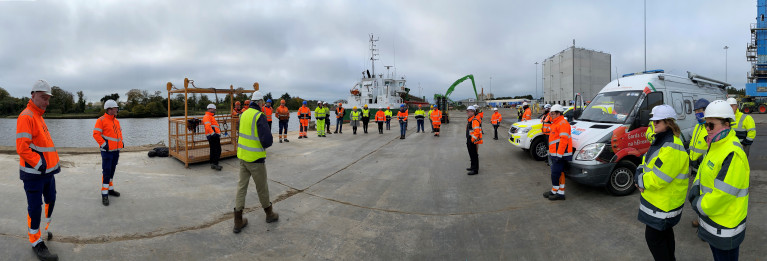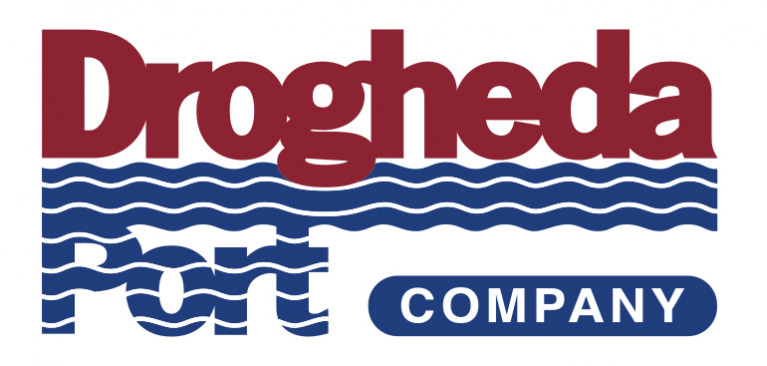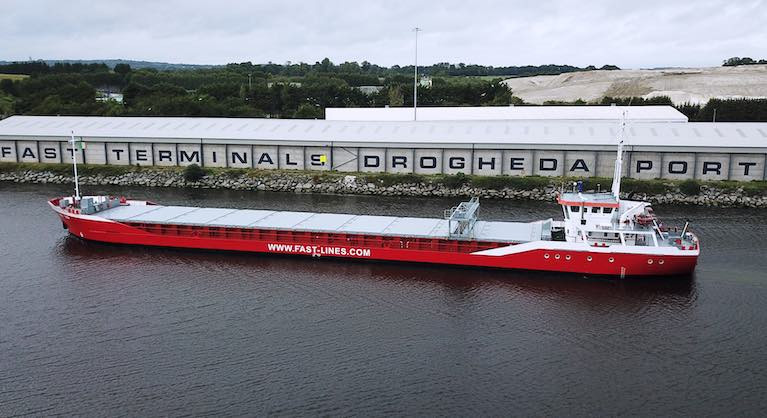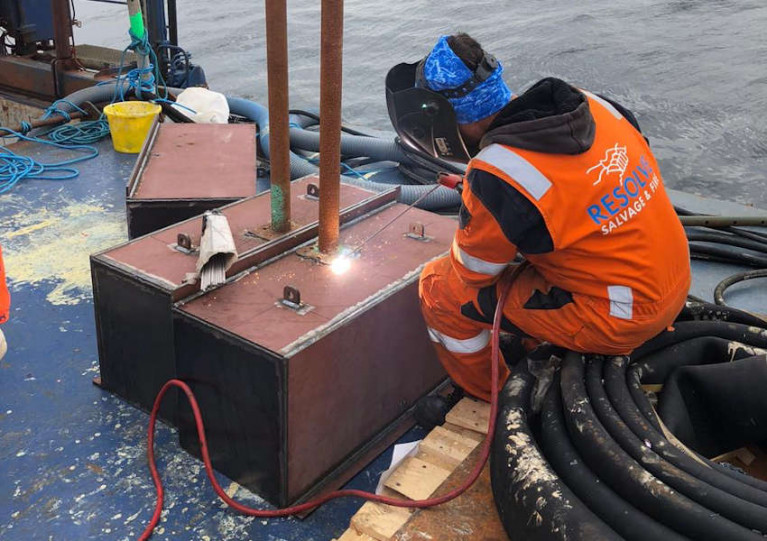Displaying items by tag: Drogheda Port
Drogheda Port Welcomes Delegation From Southwest Ports of Finland
A delegation comprising managing directors and key personnel from six major ports in the Southwestern part of Finland, headed by Mr. Anders Ahlvik, MD of Port of Hanko, visited Drogheda Port on the Irish east coast on Tuesday, 26th of September.
The purpose of the visit was to explore new avenues for trade facilitation and deepen maritime partnerships between Finland and Ireland.
The visit was also attended by government officials from the Finnish Embassy in Dublin, Deputy Head of Mission Saara Heinola, and Intern Reetta Pirttikoski, along with industry leaders and manufacturers from companies such as Mantsinen and Mecalift. The welcome party comprised of Drogheda Port Company Chairman Dr. Joe Hiney, Harbourmaster Captain Laurence Kirwan, and President of the Drogheda Chamber of Commerce, Mr. Hubert Murphy.
"aiming to deepen maritime partnerships between Finland and Ireland"
Captain Laurence Kirwan expressed his enthusiasm with the visit, stating, "We were delighted to welcome the delegation from the Southwest Ports of Finland. This visit underscores the importance of international collaboration in the maritime industry. We look forward to exploring new avenues for growth and development together."
The visit of the Southwest Ports of Finland delegation to Irish ports, and in particular Drogheda Port, symbolises the strong historical ties and shared commitment to sustainable maritime development between Finland and Ireland. Drogheda Port says it is pivotal in the maritime collaboration between Finland and Ireland, as these six ports handle one-third of the total movement of goods by Finnish ports both domestically and internationally.
Drogheda Port Company Recruiting for Marine Officer/Relief Pilot
Drogheda Port is Ireland’s premier regional port. Established under the Harbours Act 1996, this commercial semi-State multi-modal port has a tonnage throughput of circa 1.5m tonnes and 800 ship movements per annum. Vessels are typically in the range of 4,000-5,500dwt.
To meet its increased growth capacity, Drogheda Port Company is recruiting for a Marine Officer/Relief Pilot.
The role of the Marine Officer is to assist with regulation of shipping, cargo operations, hydrographic surveys, port security, environmental controls, pilotage operations, pilot boat maintenance, port estate maintenance, statutory compliance and reporting, port projects, development and planning.
In addition, the Marine Officer is also responsible for the provision of relief pilotage services to ships’ masters accessing/egressing Drogheda Port during the operation tidal window. The pilotage service is tidal year-round with a roster system shared with full-time licensed pilots.
Candidates must have as a minimum qualification a valid Chief Mate Unlimited STCW Regulation II/2. Sailing in the position of Mate or Master and or Pilotage Exemption Certificates with small boat handling advantageous but not essential.
Other requirements include:
- Competent knowledge of vessel operations and technical requirements including safety procedures (previous port experience advantageous but not essential)
- Good financial knowledge of budgets and maintaining cost control whilst maintaining the company standards of safety and quality
- Analytical and problem-solving skills
- Excellent interpersonal skills
- Excellent organisational skills
- Excellent IT skills
This position will be full-time. Further details of the position and application process are available from [email protected].
Applications must be received by the closing date of Friday 22 September.
Drogheda Port Company (DPC) has taken over full control of Fast Terminals Ireland Limited, the stevedoring company in Drogheda Port, in which it held a 50% shareholding.
DPC has acquired the remaining 50% shareholding from its partner Fast Lines Belgium NV.
Fast Lines Belgium NV will remain an important customer of Drogheda Port and currently operates the regular Bel-Eire service from Antwerp to Drogheda with conventional cargoes, offering a direct
continental service to both importers and exporters.
Following the acquisition, the company will trade as East Terminals and continue to offer a complete stevedoring service to all customers in Drogheda Port.
Speaking for Drogheda Port Company, Mr Paul Fleming CEO stated “strategically this is an important move for Drogheda Port and allows a continued investment in personnel and equipment in East Terminals to ensure the long-term sustainability of Drogheda Port and allow us to continue to compete against other ports on the East Coast of Ireland. We are also extremely happy that we will be continuing our long relationship with Fast Lines Belgium into the future and remain their premier port of call in Ireland.”
Speaking for Fast Lines Belgium NV, Ms Catrien Scheers Chair, said “Since the stevedoring partnership was founded in the year 2000 a lot of work has been done by both partners, Drogheda Port Company and Fast Lines Belgium, to make Fast Terminals a premium port terminal stevedore for handling and storage of breakbulk and bulk cargoes on the Irish east coast. Now the time is right to step out as partner in the JV company and focus on the continued growth of trade volumes between Antwerp and Drogheda. Fast Lines Belgium will continue its presence and operations in
Drogheda with the Bel-Eire breakbulk service between Antwerp and Drogheda and with our subsidiary Antara Shipping.”
Drogheda Sail Training Bursary Celebrates 10th Anniversary
In 2013, the Drogheda Sail Training Bursary was established as the country’s first scheme of its kind, funding the development of local young people through the medium of Sail Training. This anchor scheme has led to the subsequent development of similar bursary schemes across Ireland and Northern Ireland. The Drogheda Bursary Scheme relies entirely on the commitment and integrity of a small group of corporate sponsors who are very strong advocates of corporate social responsibility, youth development and community spirit.
Drogheda Port Company hosted an event for sponsors and supporters of the Drogheda Sail Training Bursary on Wednesday, 25th April, to mark the 10-year anniversary of the scheme and to express its appreciation to the sponsors and their commitment to this remarkable initiative during that period. Irish Cement, Louth County Council, Fast Terminals and Drogheda Port Company have financially driven this scheme from strength to strength over the past decade and are dedicated to its success and longevity. The event also marked the exciting announcement of a new corporate sponsor, ‘Boskalis’, a leading global company specialising in maritime services. Ms Nessa Lally of Drogheda Port Company thanked the sponsors and highlighted the many positive impacts their support has had for over 150 young people in Louth and Meath. She said the addition of the new sponsor would enable the scheme to grow and develop even further in the years to come.
Also present at the event was Mr Daragh Sheridan, CEO of Sail Training Ireland, Captain Liam Quinn and First Mate Hugh Byrne of the Brian Boru Vessel, who sailed into town for the occasion. Each of these guests spoke candidly about the ethos and aim of Sail Training as a challenging yet safe space for self-discovery and development. Voyage participants confront many demanding challenges, both physical and emotional. It is an activity that inspires self-confidence and the acceptance of personal responsibility. It promotes an acceptance of others, whatever their social or cultural backgrounds, and develops a willingness to take controlled risks. For most who undertake sail training, it is a unique and positive life-changing experience.
Mr Ray Molyneaux of Irish Cement said..’ Irish Cement is very proud to be involved in this wonderful scheme, I have witnessed how powerful and impactful the benefits of the voyages can be for the trainees and I would like to commend everyone involved, especially the Ship’s Captain and Crew who are passionate about the care and development of each trainee they encounter.’
Ms Collette Moss of Louth County Council also expressed her happiness at the success of the scheme and remarked how important it is now post covid for so many people…’a lot of young people found themselves isolated during covid and re-engaging in society has been difficult for so many. Mental Health struggles amongst young teens and young adults are more prevalent than ever. That’s why schemes like this are so vital for our people and our communities.’
The Irish Sail Training Vessel will return to Drogheda on June 05th for the first of the two 2023 voyages.
Drogheda Port Company Art Commission for 2021 Unveil ‘The Docker’
Local figurative artist Sallyanne Morgan, winner of the Drogheda Port Company Art Commission for 2021 unveiled her unique winning piece titled ‘The Docker’ at the port this week.
Drogheda Port Company were thrilled to announce the return of their annual arts commission back in July 2021 after a short absence. Submissions were invited from local artists, and it was open to any art form or medium for the creation of an internal sculpture or art piece or painting on a maritime or port-based theme. There was a great response with a wide range of excellent submissions and Sallyanne’s sculpture proposal was selected as the winner in September.
Her inspiration for the sculpture came from bygone times in the port of the hardened workmen on the quays physically handling sacks of coal and grains from the ships into the stores. Sallyanne commented ‘I was struck by the number of men that must have passed through over the years, by the loads they carried and how labour intensive it must have been. And so, the sculpture is a small homage to them; all the unknown men who spent their working lives lifting and carrying and making the Port function.’
‘The Docker’ was crafted using ferro-cement, a fibre reinforced cement which Sallyanne directly applied to a clay model. She spent six weeks perfecting this piece, getting every contour, every detail just right to encapsulate the remarkable human element. Sallyanne focuses very much on the female form in her work and enjoyed the challenge of working on the male figure for this commission.
The sculpture sits atop a piece of greenheart timber which was on the quay front on the town quays for many decades, over which many cargoes were imported and exported and many dockers traversed on a daily basis.
It is also very fitting to note that cement continues to be one of the main cargoes exported from the port.
The picture taken at the unveiling depicts the stark contrast of how working ports and the shipping industry has advanced over time, with technology and machinery now replacing human hands of ‘The Docker’.
Nessa Lally on behalf of the port company thanked Sallyanne for a fantastic piece of work which will now add to the growing maritime collection in the port which began over 20 years ago. The piece really exudes the physicality of the work and the men of a bygone era. We also look forward to the 2022 commission which will launch later this year.
Drogheda Port Participates in First Irish Port Safety Week
Irish port authorities including Drogheda Port, recently joined together through the Irish Ports Safety Forum in hosting the first Irish Port Safety Week which took place in the first week of from November.
The authorities had come together to ensure, highlight and enhance collective safety responsibility with events hosted under differing themes for each day of the safety week.
With a different theme for each day of the week, Drogheda Port put together a programme to educate and highlight the importance of PPE, traffic management, water safety and fire safety at the port, along with the Golden Rules of Drogheda Port.
“Drogheda Port Company were delighted to play its part in this inaugural Port Safety Week” said Paul Fleming, CE of Drogheda Port Company. “It was an opportunity to work collaboratively to improve safety and performance in the port sector, share experience and knowledge in order to drive continual improvement in eliminating accidents at work”.
With information sheets and fliers circulated every day, help was on hand from the Drogheda Fire Brigade and the Drogheda branch of the Irish Coastguard. Drogheda Fire Brigade attended a Major Port Evacuation Drill on Thursday and Fire Station Officer Mark McLearney along with his team outlined the role of the fire service in attending emergencies and offered real life examples and advice to the port community on how
best to deal and assist in emergency circumstances.
Drogheda’s Irish Coast Guard Unit attended on Friday and ICG Unit Operations Manager Commander Dermot McConneran and his team caried out a full Man Overboard Drill at Tom Roes Point with the attendance of their response RIB.
Captain Martin Donnelly, Harbourmaster of Drogheda Port thanked the emergency services for their attendance and participation at port safety week.
“On behalf of Drogheda Port Company, I would like to express our gratitude to the Drogheda Fire Brigade and the Drogheda Coast Guard for being so generous with their time during Port Safety Week.
Thanks to their demonstrations and talks all in Drogheda Port have learned a lot about the importance of fire safety and water safety at Drogheda Port.”
All at Drogheda Port considered this inaugural Port Safety Week to be a great success and wish to thank all the port users and employees for their participation and in making this week a success.
Drogheda Port 2021 Art Commission Announce Figurative Sculptor as Winner
Drogheda Port has announced its Annual Arts Commission for 2021 has been awarded to Drogheda born figurative sculptor, Ms Sallyanne Morgan.
Submissions were invited from local artists for an art piece from any art discipline based on a maritime or port-related theme.
Now based in Bettystown, Sallyanne has spent many years abroad, living and working in countries such as Cambodia and more recently Malta. She has worked as a community artist in the NGO 'Common Ground' and 'Respond' housing Association. She also taught ceramics to young adults in Phnom Penh and facilitated a cement workshop in Kathmandu University and had solo exhibitions in Malta and Phnom Penh. Her work currently features in two exhibitions, a joint show in the Seamus Ennis Arts Center in Naul and in The Botanic gardens, "Sculpture in Context". Sallyanne works with fibre-reinforced cement (FRC) or ferro-cement and began using this material as an alternative to clay after leaving technical college. This cement is either directly applied to the metal armature or is cast from a clay model.
For the 2021 Arts Commission, Sallyanne's objective is to capture the human element, and so the sculpture she proposes is a small homage to all the unknown men who spent their working lives lifting and carrying and making the Port function.
'There was a huge response to this year's Commission, with a wide range of excellent submissions making the awarding a difficult choice for the Port. However, in the end, we feel Sallyanne's proposal will make a wonderful contribution to our growing collection. We would like to thank all artists who responded to the invitation, and we look forward to future submissions from these artists.' said Nessa Lally of Drogheda Port Company.
Sallyanne is delighted that the Drogheda Port Company has commissioned one of her sculptures for their collection and she expects to complete the commission by the end of this year.
Drogheda Port Company are inviting applications for the position of Harbour Master for the Port of Drogheda.
Drogheda Port is the largest commercial regional port in Ireland, handling over 1.5 million tonnes of cargo per annum and over 1000 ship movements.
The Co. Louth port is projecting significant future growth and is embarking on ambitious development plans over the next number of years which will see substantial investment in the port’s infrastructure, handling capacity, technology, and safety systems.
The position of Harbour Master is key to the safe and efficient management of the Port, he\she is a member of the Executive Management Team, reporting to the Chief Executive.
The Harbour Master’s primary operational responsibilities are to ensure the Port’s marine, cargo and estate management activities operate safely and efficiently.
The role requires an in-depth understanding of ship manoeuvering principles over a wide range of vessel types/class within a confined tidal waterway.
Further details can be obtained by emailing: [email protected]
Drogheda Port Offers New Brexit Shipping Solution on the Irish Sea
Drogheda Port Company is getting ready for Brexit. As one of Ireland's leading break bulk ports, Drogheda is announcing two new breakbulk shortsea services as part of a solution for importers and exporters concerned with the impacts of Brexit.
In partnership with Fast Lines Belgium, a new service has already commenced "BEL - EIRE LINES". Bel-Eire Lines is a conventional breakbulk Liner Service connecting the port of Antwerp to the port of Drogheda, shipping goods from an EU port to an EU port. The service will reroute the cargo flows of existing and new customers shipping directly in or out of Ireland avoiding the UK.
The service caters for:
- all types of breakbulk such as steel products, bagged material, palletized goods
- cargoes currently trucked via UK land-bridge to Ireland
- smaller lots difficult to ship as full and complete cargoes
- project cargo
- trans-shipment cargo
The service is operated with Fast Lines Belgium's box-shaped short-sea vessel fleet.
A second new service will commence in December linking the port of Nogaro in Italy with the port of Drogheda. This service will also offer a full suite break bulk service linking into the central European rail network.
Mr Paul Fleming Port CEO said, "We are delighted to welcome these new services which will strengthen the strategic importance of Drogheda Port in supporting the Irish Construction Sector and provide a seamless supply chain from Europe to Ireland in a post Brexit trading environment."
Mr Simon Mulvany MD Fast Lines Ireland said "We are always looking for new growth opportunities and as experts in shipping goods in and out of Ireland to the continent these new services will form part of Irelands solution for Brexit. We will be providing an opportunity for existing and new customers to reroute their cargo flows in or out of Ireland."
Salvors successfully offloaded the last recoverable cargo from the grounded MV Kaami in western Scotland last Thursday, 30 April.
As previously reported on Afloat.ie, the MV Kaami ran aground in the Minch between Skye and Lewis on 21 March, just days after leaving Drogheda Port en route for Sweden.
The MV Kaami’s eight Russian crew were rescued within hours of the incident, but the 90m cargo vessel remains at the spot known locally as Eugenie Rock.
Work began last month to remove cargo from the vessel, and divers were able to access the hold to assess any internal damage.
Weather conditions during the early part of last week made it unsafe for the salvors to board the vessel and slowed down the salvage operation.
But more settled weather on Thursday allowed for some 30 tonnes of cargo to be removed and transferred to a landing craft for disposal.
The focus of the salvage operation is now on completing repairs to make the vessel watertight and to allow for it to be refloated.
































































